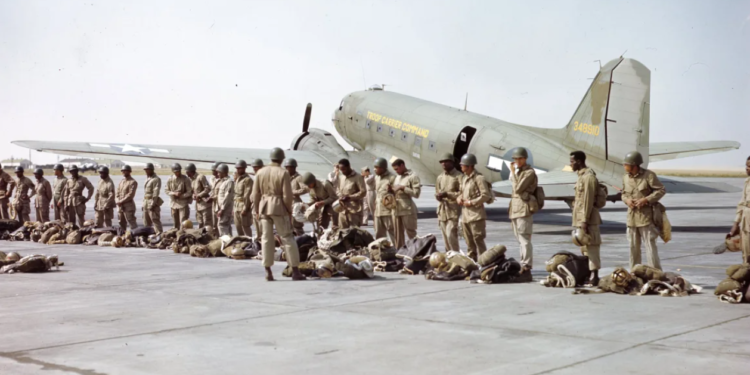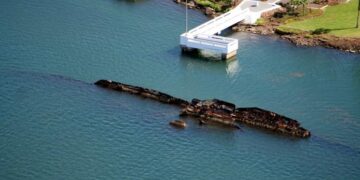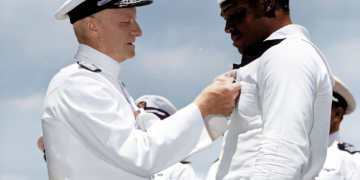April 12, 2025 Story by: Editor
A vintage World War II aircraft will soar over the funeral of Sgt. Joe Harris, paying tribute to the decorated veteran and his fellow soldiers who risked their lives in a little-known mission known as Operation Firefly—an elite, all-Black unit that parachuted into wildfires to neutralize Japan’s balloon bomb threats during WWII.
The Secret Mission of the Triple Nickles
Eighty years ago, a group of highly trained paratroopers jumped out of planes not to fight enemies on the battlefield, but to combat fires sparked by balloon bombs that Japan launched across the Pacific—the world’s first intercontinental weapons.
These men dropped into blazing forests, often landing in treetops and rappelling to the ground. When their ropes were too short, they learned to fall strategically to minimize injury. They completed over 1,200 jumps with only one casualty, a remarkable record given the dangerous terrain and mission.
All of these brave soldiers belonged to the 555th Parachute Infantry Battalion, nicknamed the “Triple Nickles.” Sgt. Joe Harris, who passed away last month in Los Angeles at the age of 108, was one of them.
“He broke barriers, he defied limits, and he proved that bravery knows no color,” Harris’ grandson Ashton Pittman told CNN.
Though their valor was not widely known at the time, Harris’ legacy now stands as a powerful example of courage and service.
“His (wartime) service was just a chapter in a long, extraordinary life,” Pittman continued. “But it’s a testament to his resilience and his honor and his unwavering dedication to something greater than himself.”
Facing a Different Kind of Battle
During most of World War II, Black servicemen were largely assigned to non-combat roles—cooking, road repair, laundry, and guarding posts—explained Robert Bartlett, a veteran and historian of the Triple Nickles.
However, 16 Black soldiers from the segregated 555th became the first African Americans to graduate from the Army’s elite Airborne School at Fort Benning, Georgia. The “Triple Nickles” name referenced their past with the Buffalo Soldiers of the 92nd Infantry Division and the buffalo nickel, albeit with a unique spelling.
When the battalion, by then 300-strong, finally received deployment orders, many expected to be sent to Europe. Instead, they were assigned to Pendleton Army Airfield in Oregon for a covert operation against a new kind of threat—forest fires caused by Japanese incendiary devices.
“They didn’t want the American people to panic that they were getting bombed by the Japanese, and they didn’t want the Japanese to know that they were successful,” Bartlett said.
“It was a secret war that the US was fighting.”
The mission, dubbed Operation Firefly, required these men to become the Army’s first military smokejumpers. Trained by the U.S. Forest Service, the Triple Nickles were equipped with fire-resistant uniforms, helmets with wire cages to shield their faces, and ropes to descend from trees safely.
Developing New Tactics
The precision, tactics, and parachuting techniques developed by the Triple Nickles laid the foundation for modern wildfire smokejumping strategies. The men also became experts in safely disposing of unexploded devices.
Sgt. Joe Harris completed 72 jumps before a failed parachute led to a serious injury and an honorable discharge from the Army.
A Legacy Overlooked
Although they marched alongside White troops in the 1946 Victory Parade in New York City—two years before the military was desegregated—the Triple Nickles still endured discrimination.
“It’s like ‘We don’t really respect you, but we need you,’” Pittman said of what his grandfather experienced.
For Bartlett, their loyalty to a country that offered them little recognition remains profound.
“These men loved their country. They loved their country, but their country did not love them,” he said.
“They saw their participation in the war as their duty. It was what you were supposed to do.”
According to Bartlett, the story of the Triple Nickles remains obscure partly because the veterans rarely spoke of their service.
Omar Bradley, who later became mayor of Compton, California, grew up next door to Harris and always sensed he had played a special role during the war.
“It’s very difficult to understand jumping into a fire,” Bradley said. “So, what it took to transform into that kind of man is something they didn’t talk about. But yes, we knew that Mr. Harris was a member of a very elite group.”
Disappearing From Public Record
Some official tributes to the Triple Nickles have quietly vanished. A U.S. Forest Service webpage titled “The Triple Nickles: A history of service, an enduring legacy” now shows only an error message: “You are not authorized to access this page.”
Additionally, content about diverse military heroes like Jackie Robinson and the Navajo Code Talkers was removed from Pentagon websites during the Trump administration’s rollback of diversity, equity, and inclusion (DEI) initiatives—though restored later amid public backlash.
A Grandson’s Tribute
After his military service, Joe Harris spent decades as a border patrol officer. Today, his grandson treasures the keepsakes he left behind, including his Triple Nickles patch and WWII jacket.
“It means the world to me. It’s a piece of history, but it’s a piece of our family’s history,” said Pittman.
In October, Pittman honored his grandfather by completing paratrooper training himself—even though he isn’t in the military.
“I felt that I needed to do it to pay respect to him and to people that have served, especially the Triple Nickles,” he said, adding that he hopes to continue jumping with veteran teams in the future.
The nonprofit Beyond the Call, which honors WWII veterans, recognized Harris’ courage:
“Joe Harris’ bravery and selflessness exemplify the spirit of the Triple Nickle Paratroopers,” the group said.
“His remarkable story serves as a reminder of the sacrifices made by those who served during World War II and the importance of honoring their legacy for future generations.”
This Saturday, Harris’ legacy will be remembered with a full military funeral—complete with a flyover tribute from the skies he once soared.
Source: CNN Edition

















